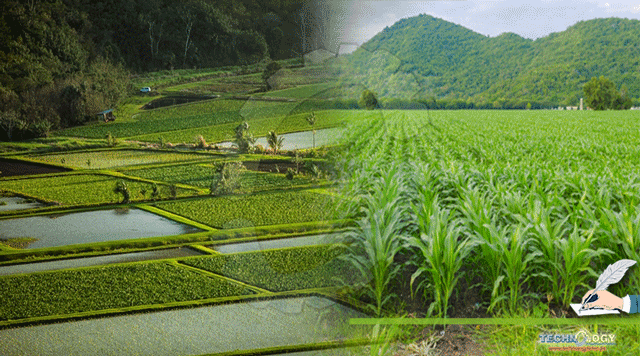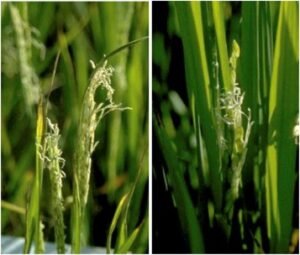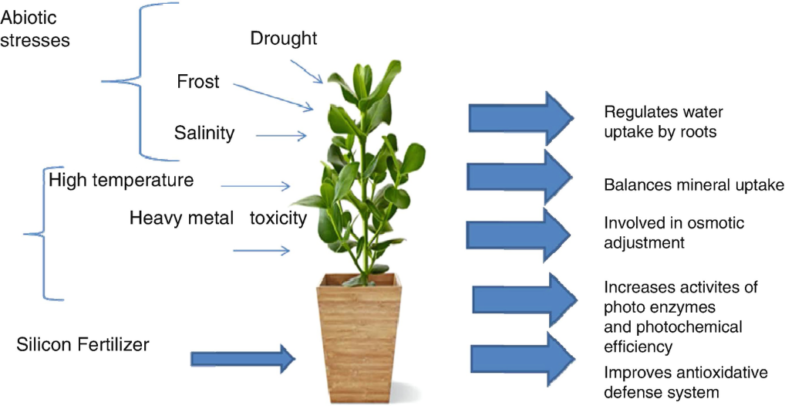The world population is continuously increasing and converting forests and fertile lands in to shelter. Humans directly or indirectly are responsible for climate change e.g. afforestation, burning of crop residues, electrical appliances, flooded rice, and automobiles etc.

By Muhammad Azhar
Climate change and its consequences on crops
Environmental stresses mainly; temperature, water, and salt stress, are the consequences of climate change compromising natural systems, human health, and agriculture production worldwide1. The progressively increasing intensities of these stresses are responsible to restrict crops to achieve their potential yields2. Temperature fluctuations adversely affect crop yield viz. heat stress reduces grain yield whereas cold stress results in sterility. The average temperature of the earth is expected to increase from 2 to 4.5 °C by 21st century3. During the last century, the annual temperature in the wheat, rice, maize, and soybean growing areas has increased by approximately 1 °C and will continue to increase in the next century with continuous greenhouse gas emissions4.
Water stress in cereals badly affects flower initiation and inflorescence5. Rice suffers disturbances in fertilization and anthesis processes under drought stress6. Drought stress also decreases the harvest index by 60% and reduces grain set7. Wheat yield is observed to be reduced from 1-30% under mild drought stress while the reduction increased to 92% where stress prolonged7. Mash bean and soybean yield was also found to be decreased by drought stress8,9. Soil salinity impairs plant growth and productivity because of water stress, cytotoxicity, and nutritional imbalance. In addition, salinity generates reactive oxygen species (ROS) which produce oxidative damage in plants10,11. In Pakistan, pollination and grain filling of maize and rice crops was badly affected from last two years due to temperature fluctuations at reproductive stage. The shift in temperature and rainfall patterns due to climate change also deteriorates the cotton crop productivity and quality.


Maize and rice pollination is negatively affected by high temperature (climate change) at reproductive stage
Silicon Phyto-nutrition
The detrimental consequences of above-mentioned environmental stresses, i.e. temperature, water, and salt stress, can be mitigated using silicon (Si). Si, previously considered as a non-essential but beneficial element, is the second largest element, in terms of abundance, found in Earth’s crust. However, smaller fraction of earth’s Si is phyto-available while most is locked up in silicate minerals not available for plants. The phyto-availability of Si is dependent on pH and redox reactions. Recently, it has been termed as “quasi-essential” element by International Plant Nutrition Institute. It is up-taken by plants in the form of soluble silicic acid [Si(OH4)]12. Si helps to tolerate abiotic stress conditions through enhanced plant growth dynamics and molecular physiology by the regulation of antioxidant defense system and hormone signaling under heat stress13. It is effective to alleviate salinity stress by regulating root development changes, redox equilibrium, photosynthesis and nutrient dynamics14. In terms of drought stress tolerance, Si strengthens plant biochemical attributes and facilitates to absorb nutrients for plant growth enhancement15.
Conclusion and recommendations
Silicon (Si) can be attributed as an element which has a broader advantageous impact on plants to mitigate environmental stresses. Owing to its beneficial role in multiple stress tolerance, it can be considered as a regular element particularly for cereals and monocots. Application of Si can be included in plant nutrition plan especially in the areas affected by environmental stresses because Si boosts plant tolerance against stresses. Along with climate resilient varieties, smartly manage water and nutrition (balanced nutrition) and add beneficial nutrients like Si to increase yield and quality of produce under changing climate.

Effect of Si nutrition on abiotic stresses (Image taken from Malhotra and Kapoor 2019; Doi; http://doi.org/10.1007/978-3-030-06118-0_14)
References
- Arunanondchai, P., C. Fei, A. Fisher, B.A. McCarl, W. Wang and Y. Yang. How does climate change affect agriculture. In The Routledge Handbook of Agricultural Economics; Routledge: Abingdon-on-Thames, UK, 2018.
- Wheeler T and J. von Braun. 2013. Climate change impacts on global food security. Science 341:508–513.
- Pachauri, R.K., M.R. Allen, V.R. Barros, J. Broome, W. Cramer, R. Christ, J.A. Church, L. Clarke, Q. Dahe and P. Dasgupta. Climate Change 2014: Synthesis Report; Contribution of Working Groups I, II and III to the Fifth Assessment Report of the Intergovernmental Panel on Climate Change; IPCC: Geneva, Switzerland, 2014.
- Nelson GC, et al. (2010) Food Security, Farming, and Climate Change to 2050: Scenarios, Results, Policy Options, IFPRI Research Monograph (International Food Policy Research Institute, Washington, DC).
- Winkel, T., J.F. Renno and W. Payne. Effect of the timing of water deficit on growth, phenology and yield of pearl millet (Pennisetum glaucum (L.) R. Br.) grown in Sahelian conditions. J. Exp. Bot. 1997, 48, 1001–1009.
- Saini, H and D. Aspinall. Abnormal sporogenesis in wheat (Triticum aestivum L.) induced by short periods of high temperature. Ann. Bot. 1982, 49, 835–846.
- Araus, J., G. Slafer, M. Reynolds and C. Royo. Plant breeding and drought in C3 cereals: What should we breed for? Ann. Bot. 2002, 89, 925–940.
- Baroowa, B and N. Gogoi. Biochemical changes in black gram and green gram genotypes after imposition of drought stress. J. Food Legum. 2014, 27, 350–353.
- Maleki, A., A. Naderi, R. Naseri, A. Fathi, S. Bahamin and R. Maleki. Physiological performance of soybean cultivars under drought stress. Bull. Environ. Pharmacol. Life Sci. 2013, 2, 38–44.
- Hernandez, J. A., M.A. Ferrer, A. Jimenez, A.R. Barcelo and F. Sevilla. 2001. Antioxidant systems and O2−/H2O2 production in the apoplast of pea leaves. Its relation with salt-induced necrotic lesions in minor veins. Plant Physiol. 127, 817–831. doi: 10.1104/pp.010188
- Isayenkov, S. V. 2012. Physiological and molecular aspects of salt stress in plants. Cytol. Genet. 46, 302–318. doi: 10.3103/S0095452712050040
- Luyckx, M.; Hausman, J.F.; Lutts, S.; Guerriero, G. Silicon and plants: Current knowledge and technological perspectives. Front. Plant Sci. 2017, 8, 411.
- Khan, A., A.L. Khan and M. Imran. 2020. Silicon-induced thermotolerance in Solanum lycopersicum L. via activation of antioxidant system, heat shock proteins, and endogenous phytohormones. BMC Plant Biol 20, 248. https://doi.org/10.1186/s12870-020-02456-7
- Liu, B., P. Soundararajan and A. Manivannan. 2019. Mechanisms of Silicon-Mediated Amelioration of Salt Stress in Plants. Plants (Basel, Switzerland), 8(9), 307. https://doi.org/10.3390/plants8090307
- Bukhari, M.A., Z. Ahmad and M.Y. Ashraf. 2020. Silicon Mitigates Drought Stress in Wheat (Triticum aestivum L.) Through Improving Photosynthetic Pigments, Biochemical and Yield Characters. Silicon. https://doi.org/10.1007/s12633-020-00797-4
Author : Muhammad Azhar, Assistant Research Officer, Engro Fertilizers Ltd. Pakistan